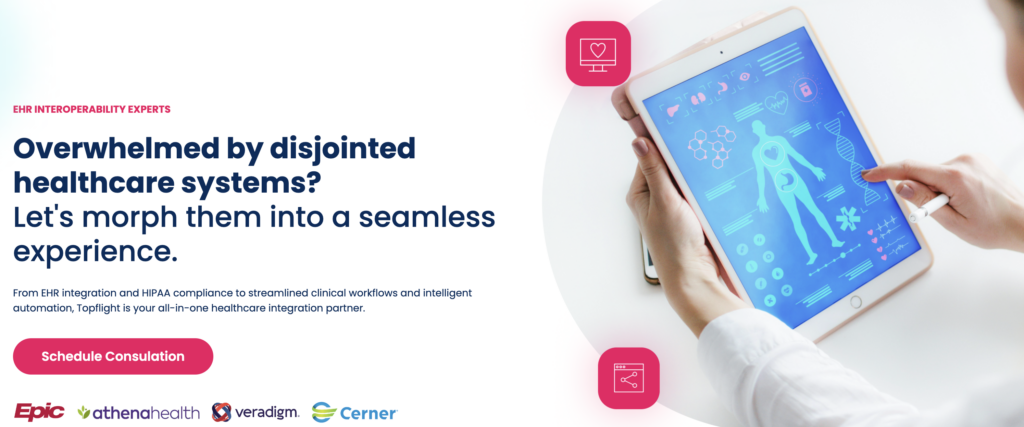Picture this: a typical day at a nursing home where Dr. Smith and her colleagues are frantically juggling patient charts, medication lists, and appointment schedules. Every moment is a race against time. Disjointed systems scatter critical patient information across different platforms, leading to medication errors, missed treatments, and frustrated staff bogged down by manual data entry. The inefficiencies are glaring, impacting both the quality of care and overall workflow.
What if Dr. Smith could access an all-in-one solution that integrates seamlessly with existing systems — this is where PointClickCare steps in. By setting up PointClickCare EHR integration, clinical CIOs and VPs of Technology can transform these chaotic environments into models of efficiency and improved patient care.
This guide will delve into mastering EHR PointClickCare integration, providing actionable insights for optimizing operations and boosting key performance indicators, ensuring that professionals like Dr. Smith can focus on what they do best: delivering exceptional patient care.
Top Takeaways:
- Streamline Operations: PointClickCare EHR integration eliminates data silos, automates workflows, and reduces manual entry errors, leading to improved efficiency and better patient care outcomes.
- Enhanced Decision-Making: Real-time data access and sophisticated analytics enable healthcare leaders to make informed decisions quickly, ensuring high-quality care and optimized operational performance.
- Proven Success: Case studies like Luther Manor and TriHealth PAC Network show significant achievements, such as a 98% assessment completion rate and a 20% reduction in admin tasks, highlighting the tangible benefits of PointClickCare integration.
Table of Contents
- PointClickCare Landscape for Clinical Leaders
- Key Features of PointClickCare EHR
- Streamlining Workflow and Overcoming Challenges
- Unlocking the Potential of PointClickCare EHR Integration
- Navigating the EHR PointClickCare Integration Process Step by Step
- Optimizing Performance: Measuring Success Through KPIs
- Success Stories of PointClickCare Integration
- Topflight: Your Trusted Guide for EHR Integrations
PointClickCare Landscape for Clinical Leaders
Understanding PointClickCare’s landscape is crucial for clinical leaders aiming to drive innovation and enhance operational efficiency in their facilities.
What is PointClickCare?
PointClickCare is a registered trademark and a cloud-based healthcare software provider, specifically designed to improve the quality of care in long-term and post-acute care facilities. Their comprehensive suite of solutions, including an EHR platform, covers clinical, financial, and administrative operations, making it an indispensable tool for skilled nursing facilities (SNFs), senior living communities, and home health care providers.
PointClickCare’s Position on the Long-Term and Post-Acute Care Market
In the LTC/PAC market, PointClickCare stands out as a pivotal player due to its robust and scalable platform. The company addresses the unique challenges faced by these facilities by offering tools that streamline workflows, enhance patient care, and ensure regulatory compliance.
- 60 percent market share in the Skilled Nursing space
- Customers: 27,000+ long‐term and post‐acute care providers, 3,100+ hospitals and health systems, 2,200 ambulatory clinics, all major health plans across the US, and 70+ state and government agencies
- Recognized as the top Long-Term Care Software Provider by KLAS Research (2019-2024)
- Acquisitions: American HealthTech (2024), Patient Pattern (2023), and Audacious Inquiry (2022)
Of course, there are other EHR platforms on the market, too, that can help medical organizations automate their workflows. Check out our dedicated blog about how to choose an EHR system for a more comprehensive overview of different EHR solutions.
Growing Importance of LTC/PAC for Healthcare Systems
The LTC/PAC sector is becoming increasingly vital to overall healthcare systems due to the aging population and the chronic conditions that come with it. The need for seamless data flow and care transitions between hospitals, skilled nursing facilities, and senior living communities is more critical than ever.
According to the U.S. Census Bureau, the number of Americans aged 65 and older is projected to nearly double from 52 million in 2018 to 95 million by 2060. This demographic shift underscores the importance of integrating systems like PointClickCare to ensure continuous and coordinated care.
Core Functionality
PointClickCare’s core functionality revolves around several key areas:
- Clinical Management: Provides real-time access to patient records, medication management, and care planning tools.
- Financial Management: Streamlines billing, revenue cycle management, and financial reporting.
- Administrative Tools: Enhances scheduling, staffing, and overall facility management.
By leveraging these functionalities, PointClickCare enables LTC/PAC facilities to operate more efficiently, improve patient outcomes, and stay compliant with regulatory requirements.
Key Features of PointClickCare EHR
Imagine a world where your clinical operations run seamlessly, with real-time data, efficient workflows, and improved patient outcomes. This isn’t just a dream; it’s entirely possible with PointClickCare EHR integration. This powerful tool bridges the gap between disparate systems, ensuring that every piece of critical information is connected, accessible, and actionable.
Interoperability and Data Exchange
PointClickCare fosters interoperability by breaking down data silos, ensuring smooth information flow between different systems. This seamless data exchange:
- Enhances care coordination across various settings (e.g., hospitals to skilled nursing facilities).
- Reduces the risk of errors by ensuring all providers have access to the same up-to-date information.
- Facilitates comprehensive care by integrating with other EHR systems and health IT applications.
Read more on EHR software development
Real-Time Data Access and Analytics
Real-time access to data is a game-changer for clinical operations. With PointClickCare, healthcare providers can:
- Monitor patient status and treatment progress immediately, leading to more responsive and timely care adjustments.
- Utilize advanced analytics to identify trends, predict outcomes, and make data-driven decisions.
- Improve patient outcomes through proactive interventions based on real-time insights.
Workflow Automation and Efficiency
Efficiency is at the core of PointClickCare integration solutions. By automating routine tasks and streamlining workflows, healthcare organizations can:
- Reduce administrative burdens, freeing up staff to focus on patient care.
- Minimize manual data entry, lowering the risk of human error.
- Enhance productivity by optimizing scheduling, billing, and compliance processes.
Accessibility and Mobility
PointClickCare offers easy access to resident records both in the office and on the go. The mobile charting feature enhances mobility, allowing for bedside documentation and care management.
PointClickCare Marketplace
The PointClickCare Marketplace creates a robust ecosystem of partner solutions that are seamlessly integrated with the EHR. It showcases cutting-edge innovations, such as AI software leveraging machine learning in healthcare use cases, to boost nursing capacity, streamline physician rounds, and cut costs in post-acute care settings.
Comprehensive Health Care Planning and Management
PointClickCare provides a full suite of tools for healthcare planning and management, enabling providers to create and manage care plans effectively. This includes specialized assessments and management of Minimum Data Set (MDS) processes, which are crucial for senior care.
Here are a few more standout features of the PointClickCare EHR platform:
- Medication and Wound Care Management: Streamlines medication administration and supports wound care management.
- Financial and Administrative Automation: Simplifies billing and reimbursement; automates admissions, referrals, and staff scheduling.
- Integration and Interoperability: Seamless integration with third-party systems for medication management, therapy tracking, and telehealth.
- Customization of Workflows: Aligns workflows with specific operational needs.
- Data Management and Reporting: Advanced tools for analyzing key metrics and generating custom reports.
- Real-Time Communication and Collaboration: Facilitates communication via messaging systems, alerts, and notifications.
- Telehealth and Remote Engagement: Supports remote patient engagement through telehealth services.
- Staff and Shift Scheduling: Optimizes resource allocation and reduces staffing challenges.
- Fall Management and Prevention: Includes tools to enhance patient safety.
- Security and Compliance: Ensures robust security and compliance with healthcare regulations.
Of course, this robust feature set is made possible by the system’s foundation as a healthcare cloud computing platform.
Streamlining Workflow and Overcoming Challenges
Embarking on a PointClickCare EHR integration project can be transformative, but not without its hurdles. Let’s delve into some typical challenges clinical CIOs and VPs of Technology encounter and how to tackle them effectively.
Data Silos and Information Fragmentation Hindering Care Coordination
In many healthcare settings, data is often trapped in silos, making it difficult to share critical patient information across departments. This fragmentation can severely hinder care coordination, leading to delays, duplications, and errors in patient care. For instance, if a patient’s medication history isn’t accessible to all necessary parties, it could result in missed doses or harmful interactions.
Manual Data Entry Leading to Errors and Inefficiencies
Reliance on manual data entry is another significant pain point. Not only is this process time-consuming, but it also opens the door to human error. These mistakes can lead to inaccurate patient records, billing issues, and overall inefficiencies that bog down staff productivity. Imagine the difference when your team can rely on automated data entry to ensure accuracy and save valuable time.
Difficulty in Gaining Real-Time Insights Across the Care Continuum
Access to real-time data is crucial for making informed decisions quickly. However, integrating systems to achieve this can be complex. Without seamless data flow, gaining a holistic view of a patient’s journey—from hospital to LTC/PAC facilities or home care—becomes challenging. This lack of real-time insights can impede timely interventions and affect patient outcomes.
How PointClickCare Integration Can Address These Pain Points
Fortunately, PointClickCare integration can effectively address these challenges, offering solutions that streamline workflows and enhance operational efficiency.
- Breaking Down Data Silos: PointClickCare facilitates seamless data exchange between different systems, ensuring that all relevant patient information is accessible to authorized personnel. This eliminates fragmentation and promotes coordinated care.
- Reducing Manual Entry: By automating data entry processes, PointClickCare significantly reduces the likelihood of errors and frees up staff to focus on direct patient care. Automated workflows enhance accuracy and speed, improving overall efficiency.
- Enabling Real-Time Insights: With PointClickCare, healthcare providers gain real-time access to critical data, allowing for timely and informed decision-making. This capability is essential for monitoring patient progress and making adjustments as needed, ultimately improving patient outcomes.
By addressing these common challenges, PointClickCare integration not only streamlines operations but also supports better care coordination, improved accuracy, and enhanced efficiency. As clinical CIOs and VPs of Technology, leveraging these solutions can revolutionize your healthcare facility’s performance and patient care standards.
Unlocking the Potential of PointClickCare Integration
Integrating PointClickCare with your existing electronic health record systems presents a plethora of opportunities to elevate healthcare delivery, streamline operations, and enhance financial health. Let’s explore these key opportunities.
Enhanced Care Coordination and Improved Patient Outcomes
Seamless integration of PointClickCare ensures that all patient data is centralized and easily accessible across various care settings, from hospitals to long-term care and skilled nursing facilities. This level of interoperability:
- Facilitates smooth transitions of care, reducing gaps in information.
- Enhances collaboration among healthcare professionals.
- Leads to more informed decision-making, ultimately improving patient outcomes.
Enhancing Patient Engagement and Experience
With real-time data access and efficient communication channels, PointClickCare integration can significantly boost patient engagement. Patients benefit from:
- Timely updates on their health status.
- Enhanced communication with their care team.
- A more personalized care experience leads to higher satisfaction rates.
Reduced Administrative Burden and Improved Staff Productivity
By automating workflows and reducing manual data entry, PointClickCare integration helps minimize administrative tasks. This automation:
- Frees up healthcare staff to focus more on patient care rather than paperwork.
- Reduces the risk of errors associated with manual entry.
- Improves overall staff productivity and job satisfaction.
Streamlined Data Analysis and Reporting for Better Decision-Making
PointClickCare’s robust analytics capabilities provide actionable insights into clinical and operational performance. This functionality enables:
- Real-time monitoring of key performance indicators (KPIs).
- Data-driven decision-making.
- Rapid identification of areas for improvement, enhancing both clinical and financial health.
Compliance and Regulatory Support
Navigating the complex landscape of healthcare regulations is a challenge for any hospital health system. PointClickCare integration offers:
- Tools to ensure compliance with industry standards and regulations, such as HIPAA rules.
- Automated reporting features that simplify adherence to regulatory requirements.
- Pre-built templates and reporting tools tailored to specific regulatory requirements.
- Peace of mind knowing that your organization is always up-to-date with compliance.
Also Read: HIPAA Compliant App Development Guide
Increased ROI
Investing in PointClickCare integration can lead to substantial returns and increase revenue in medical practices. The efficiency gains and improved patient outcomes contribute to:
- Reduced operational costs.
- Increased revenue through better care coordination and patient retention.
- A stronger financial position, making it easier to scale operations and invest in further innovations.
Scaling Operations with Seamless Integration
As your healthcare organization grows, so do the complexities of managing data across multiple systems. PointClickCare’s scalable solutions allow you to:
- Expand your operations without compromising data integrity or workflow efficiency.
- Maintain consistency in care delivery across all locations.
- Continue leveraging technology advancements to stay competitive in the healthcare market.
Use Cases Where PointClickCare Integration Creates Significant Value
To illustrate the tangible benefits of PointClickCare integration, consider these real-world scenarios:
- Medication Reconciliation: Automatically updating medication lists across various care settings ensures accuracy and safety, preventing adverse drug interactions.
- Smoother Patient Transitions: Seamless data exchange during patient transfers between hospital health systems and LTC/PAC facilities minimizes disruptions and ensures continuity of care.
- Enhanced Chronic Disease Management: Real-time data analytics help identify at-risk patients early, allowing for timely interventions and better management of chronic conditions.
By unlocking these opportunities, clinical CIOs and VPs of Technology can drive significant improvements in their organizations’ healthcare delivery and financial health. Integrating PointClickCare with your EHR systems isn’t just a technical upgrade—it’s a strategic move towards optimized healthcare.
Navigating the EHR PointClickCare Integration Process
When it comes to EHR PointClickCare integration, planning and precision are key to ensuring a smooth and effective process. As CIOs and VPs of Technology, understanding the steps involved can help you lead your team to success. Here’s a step-by-step guide to navigating this journey.
Key Steps Involved in a Successful PointClickCare EHR Integration Project
Transforming your facility’s electronic health record system with PointClickCare involves several critical phases. Let’s break down each step to ensure a seamless integration process. How about we first list all of the steps?
- Step #1: Identify goals and create a data mapping scheme
- Step #2: Select the optimal system setup and configuration
- Step #3: Migrate data
- Step #4: Deploy and monitor
- Step #5: Train personnel
Step #1: Planning and Assessment
- Define Clear Objectives: Start by identifying the specific goals you aim to achieve with EHR PointClickCare integration. Whether it’s streamlining workflows or enhancing patient care, clarity is crucial.
- Data Mapping: Outline the data that needs to be exchanged between your current systems and PointClickCare. This includes patient records, billing information, and clinical documentation.
Step #2: System Selection and Configuration
- Select Compatible Systems: Ensure the systems you choose are optimized for the browser and compatible with other third-party applications. Compatibility will minimize roadblocks during the integration process.
- Configuration: Tailor the configuration settings to meet the unique needs of your healthcare facility. This might involve customizing workflows to appear as designed specifically for your operational requirements.
Step #3: Data Migration + Development and Testing if EHR Customization is Required
- Data Migration: Carefully plan and execute the migration of existing data to the new system. It’s essential to maintain data integrity and avoid any loss of critical information.
- Customization and Testing: If your EHR requires customization, engage in thorough development and testing. This phase ensures that all functionalities work as expected and that customizations align perfectly with your operational needs.
More on how to develop a hospital management system in our dedicated blog.
Read more on EHR data migration
Step #4: Implementation and Ongoing Support
- Implementation: Roll out the PointClickCare integration across your facility. Ensure minimal disruption to daily operations by choosing a strategic time for deployment.
- Ongoing Support: Provide continuous support to address any issues that arise post-implementation. Continuous monitoring and maintenance are vital to sustain system performance and user satisfaction.
Step #5: User Training
- Comprehensive Training: Provide extensive training sessions for all users, from clinicians to administrative staff. Well-trained personnel are crucial for maximizing the benefits of the new system.
- User Manuals and Resources: Offer user-friendly manuals and resources to facilitate ongoing learning and quick troubleshooting.
Best Practices for a Smooth Integration
- Stakeholder Engagement: Involve key stakeholders throughout the integration process to gather input and secure buy-in.
- Iterative Testing: Conduct iterative testing during different phases of integration to catch and resolve issues early.
- Feedback Loop: Establish a feedback loop where users can share their experiences and suggest improvements, ensuring the system evolves to meet their needs effectively.
- Parallel Operation of Old and New Systems: Maintain the old system running in parallel with the new integration for a transitional period, typically a month or so. This approach provides a safety net to address any unforeseen issues without disrupting daily operations.
By following these steps meticulously, you can ensure that your EHR PointClickCare integration project is not only successful but also brings about transformative improvements in your healthcare organization’s medical practice management system. As our product managers love to emphasize, the goal of software development isn’t just to build systems but to create solutions that enhance efficiency, improve patient care, and ensure financial health.
Optimizing Performance: Measuring Success Through KPIs
Understanding and measuring success is vital for any EHR PointClickCare integration project. By focusing on key performance indicators (KPIs), clinical leaders can ensure the best possible outcomes for their organizations. Let’s explore the most relevant KPIs to monitor and improve.
Defining KPIs for PointClickCare Integration Success
To gauge the effectiveness of PointClickCare integration, consider tracking the following KPIs:
- Operational Efficiency: Measure how the benefits of integrated healthcare streamline processes and reduce bottlenecks, ensuring smoother workflows and faster patient data access.
- ROI and Cost-Benefit Analysis: Quantify the financial health improvements by comparing the costs of integration with the savings from increased efficiency and reduced errors.
- User Adoption: Track how quickly and effectively staff members adapt to the new system, which correlates with overall satisfaction and productivity.
- Patient Satisfaction Rates: Monitor improvements in patient experiences and outcomes as a result of enhanced care coordination and real-time data access.
- Data Accuracy and Completeness: Assess the quality of patient records and information flow, which is critical for reliable decision-making.
- System Downtime and Uptime: Ensure the best possible system reliability by evaluating the availability and performance of the integrated EHR system.
Reduction in Medication Errors
Tracking the frequency and severity of medication errors before and after integration can provide clear evidence of the system’s impact on patient safety. A reduction in these errors indicates better data accuracy and improved communication among care teams.
Improved Timeliness of Care Transitions
Measure the time taken for patient data to be transferred during care transitions, such as from hospital to senior care facilities. Faster, more accurate transitions signify successful interoperability and enhanced care coordination.
Increased Staff Satisfaction and Productivity
Monitor changes in staff productivity and job satisfaction by conducting regular surveys and performance reviews. Higher satisfaction often translates to more efficient workflows and better patient care.
Enhanced Data Quality and Reporting Efficiency
To ensure ongoing success, continuously monitor these KPIs and adjust strategies as needed. Regularly review performance data, gather feedback from users, and stay updated with industry best practices. This proactive approach helps demonstrate the ROI of PointClickCare integration and supports sustained improvements.
By focusing on these KPIs, clinical CIOs and VPs of Technology can not only track the success of their PointClickCare integration but also drive meaningful improvements in operational efficiency, patient care, and overall organizational performance. Aim high and make your senior care facilities models of excellence in healthcare delivery.
Success Stories of PointClickCare Integration
Real-world examples of PointClickCare integration illustrate the system’s profound impact on healthcare operations and patient outcomes. Here are some standout success stories:
Avamere: Transforming Care Coordination
Avamere Family of Companies leveraged PointClickCare’s Nursing Advantage to streamline documentation, improve care coordination, and achieve a significant 55% reduction in long-stay rehospitalizations across their facilities.
Luther Manor: Documentation Efficiency
Luther Manor’s experience exemplifies the power of PointClickCare integration for documentation accuracy and efficiency. Their impressive achievement of a 98% completion rate for resident assessments showcases a significant improvement. This likely translates to more comprehensive care plans and potentially better patient outcomes.
TriHealth PAC Network: Streamlined Workflows
TriHealth PAC Network’s success story highlights a clear benefit of PointClickCare integration: reduced administrative burden. They achieved a measurable 20% reduction in administrative tasks after implementing PointClickCare.
Topflight: Your Trusted Guide for EHR Integrations
At Topflight, we pride ourselves on our extensive experience in EHR integration projects. While we haven’t worked specifically with PointClickCare just yet, our portfolio includes successful integrations with major EHR systems like Epic, Cerner, and Allscripts.
For instance, we helped a leading OC hospital seamlessly integrate patient-facing applications with their Epic system, enhancing patient lookup efficiency with FHIR API and deploying the app to Epic’s app store. Our work with GaleAI further demonstrates our capability in complex EHR integration, making it available as a plug-in module in the AthenaHealth Marketplace.
By the way, PointClickCare offers its own ecosystem of partner solutions, a marketplace with health apps directly integrated with the platform. That’s a perfect space for third-party developers to create and integrate applications that enhance the functionality of PointClickCare EHR.
Benefits of Partnering with Topflight
When you partner with Topflight for your PointClickCare EHR integration, you gain access to a wealth of benefits tailored to meet the unique needs of your organization:
- Proven Track Record: We have consistently enabled healthcare facilities to streamline workflows, enhance data accuracy, and improve patient outcomes.
- Deep Understanding of PointClickCare and the LTC/PAC Landscape: Our team understands the intricacies of long-term and post-acute care environments. We leverage this knowledge to ensure your PointClickCare integration enhances care coordination and operational efficiency.
- Customized Solutions and Ongoing Support: We recognize that each healthcare facility is unique. That’s why we offer personalized solutions to meet your specific goals. Additionally, our commitment doesn’t end at implementation; we provide ongoing support to ensure your system continues to perform at its best.
Partnering with Topflight means you’re choosing a team that is dedicated to optimizing your healthcare operations through innovative technology solutions. We invite you to schedule a call with our lead EHR integration experts to explore how we can assist with your PointClickCare EHR integration project. Contact us today to take the first step towards seamless integration and optimized healthcare delivery.
PointClickCare integrates by seamlessly connecting various EHR systems, enabling real-time data exchange and automated workflows, which enhance patient care, improve operational efficiency, and reduce manual errors. Common challenges include managing data silos, ensuring interoperability with existing systems, addressing user adoption, and minimizing downtime during transition. Effective planning and support can mitigate these issues. Future trends include greater emphasis on interoperability, advanced data analytics for predictive care, increased use of AI to streamline workflows, and enhanced mobile access for care providers. The cost of a PointClickCare EHR integration project varies depending on the complexity of your current systems, required customizations, and scale of implementation. It’s best to consult with an integration expert for a tailored estimate.Frequently Asked Questions
How does PointClickCare integration work in the healthcare industry?
What are the typical challenges faced while implementing PointClickCare integration?
What are the future trends of PointClickCare integration for the healthcare industry?
How much does it cost to integrate EHR with PointClickCare?





